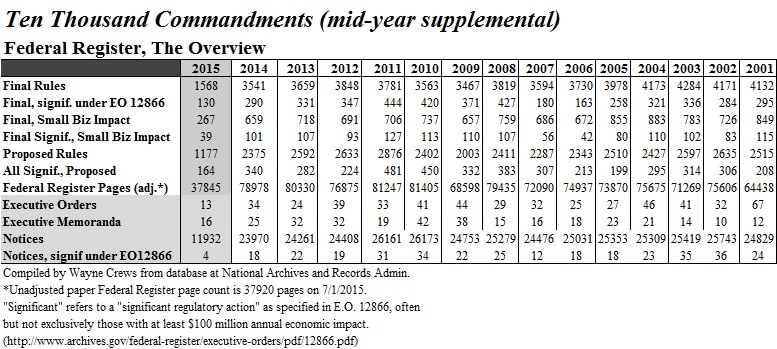Independence Day? Yeah, Right: A Fourth of July Roundup of Federal Regulation

Congress is in recess and can’t do any more damage as the Fourth of July approaches, but federal agencies remain in business until they enjoy their federal holiday on Friday.
That matters. In our annual Ten Thousand Commandments, we show that those federal agencies now do the bulk of lawmaking in the founders’ republic, never mind their having been elected by no one. And over-regulation is a bipartisan phenomenon.
At calendar year-end 2014, the Federal Register stood at 77,687 pages. The Register is the daily depository of federal rules, regulations, notices and presidential documents. While that’s “only” the sixth highest level ever, five of those six have occurred under the current administration.
Among those pages, there were 3,554 final rules (with another 2,383 at the proposed stage). Congress passed 224 laws during the year. So the multiple of agency rules over laws was 16. I like to call that multiple the “Unconstitutionality Index.”
So here we are, at nearly mid-year. What have the agencies been up to in 2015?
Well, the Federal Register stands at 37,845 pages as of today, July 1.
The number of final rules issued so far in 2015 is 1,568. Of these, 130 are considered “significant” under E.O. 12866. Often that means they may cost over $100 million annually, sometimes they are considered significant for other more or less dramatic reasons, like when they do something “serious,” “material,” or “novel.”

There’re plenty proposed rules coming too: those stand at 1,177. Of those proposed rules, 164 are considered “significant,” so their relative punch is even greater than what’s been issued so far.
Small businesses take a hit from regulations too; 267 of this year’s final rules affect them, and 39 of those are considered “significant.”
We’ve heard a lot in the past few years about the administration’s “pen and phone,” and going around Congress. President Obama has issued 13 Executive Orders and 16 presidential memoranda so far this year. Obama is nowhere close to the record-holder with respect to Executive Orders this year or during his administration overall.
However, this administration has made significant use of Executive Memoranda compared to earlier ones. That practice and other kinds of federal agency “Regulatory Dark Matter” like guidance documents, memos, bulletins, letters, lawsuits, notices, press releases and blog posts need serious attention from policy makers.
For example, there are 11,932 Notices issued by agencies so far in 2015; most are ordinary announcements like meetings and hearings (which do matter); but some even are considered “significant.”
The growth of regulations can only be addressed by Congress, unless—speaking of Independence Day!—Congress prefers to chance the states taking advantage of a teensy little bit of language contained in the Constitution's Article V; “two thirds of the several States [can] call a Convention” to take power back from Washington.
It needn't come to that; there are several reform measures under discussion on Capitol Hill, from the REINS Act (Regulations from the Executive In Need of Scrutiny), the Regulatory Accountability Act (H.R. 185) from Rep. Bob Goodlatte, proposals for a regulatory reduction commission like Sen. Orrin Hatch’s SCRUB Act and the Angus King/Roy Blunt Regulatory Improvement Act, and even regulatory budgets like those described by Sen. Marco Rubio, Rep. Steve Scalise, and Sen. Mike Lee. Sunsets and “one-in, one-out” proposals are in play, too.
President Obama promises vetoes. But if sensible reforms are brought to the floor of Congress, it is doubtful that members of even of his own party will go to the mat defending the modern bureaucracy, particularly as the “dark matter” portion of it expands.
For detailed regularly updated data on regulations, go here to www.tenthousandcommandments.com; for year-end data and trends going back to the 1990s, check out this roundup chart.